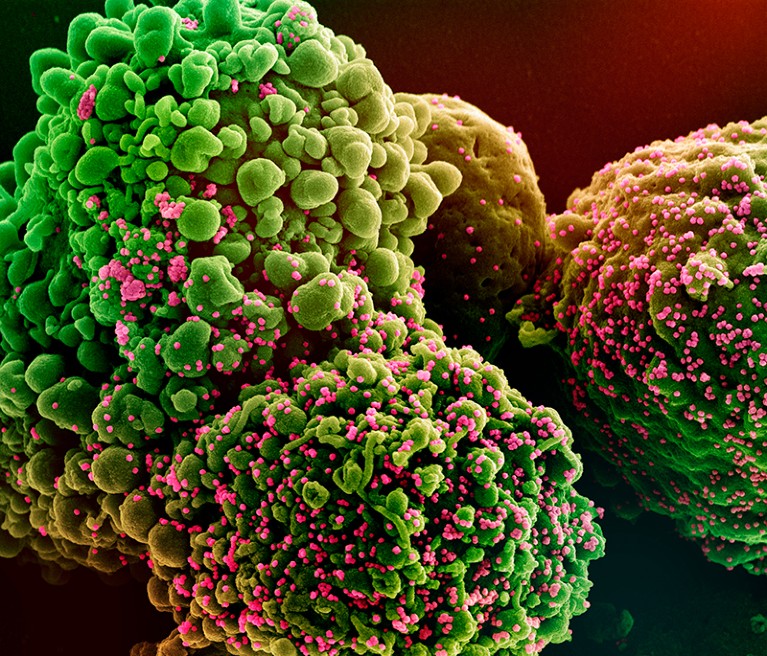Hello Nature readers, would you like to get this Briefing in your inbox free every day? Sign up here

A cell (green) infected with the Omicron variant of SARS-CoV-2 (pink).Credit: National Institutes of Health/Science Photo Library
Red-hot controversy over risky COVID research
Researchers who inserted a gene from the Omicron variant of SARS-CoV-2 into another strain of the virus have triggered a fierce controversy over what constitutes perilous COVID-19 research. The team at Boston University, Massachusetts, was trying to understand why Omicron causes mild disease. But the experiments have sparked a debate: whether researchers who are modifying pathogens need to keep regulators and funding agencies informed about their work, and when they should do so. The controversy highlights “the lack of clarity that people have on exactly what sorts of experiments have benefits that outweigh risks, and who decides how it’s all reviewed”, says evolutionary virologist Jesse Bloom.
Reference: bioRxiv preprint 1 & bioRxiv preprint 2 (both not peer reviewed)
Nobel laureate’s work is under scrutiny
Several research articles co-authored by Nobel-prizewinning geneticist Gregg Semenza are being investigated by publishers following concerns about the integrity of images in the papers. Journals have already retracted, corrected or expressed concerns about 17 of his publications over the past decade, and others are investigating image- and data-integrity issues in further studies. Commenters on the website PubPeer — where users scrutinize published research — have questioned images in 52 articles co-authored by Semenza. Image-integrity consultant Elisabeth Bik has pointed out irregularities in Semenza’s work. In her opinion, “the fact that there are multiple papers now retracted for manipulated images, and several others still under investigation suggests an intention to mislead”.
Contamination fears after Nord Stream blast
Researchers are rushing to find out whether explosions in the Nord Stream gas pipelines in September have caused environmental damage by stirring up pollutants from discarded chemical weapons. The blasts happened very close to a Danish island that houses chemical weapons that were dumped by Germany after the Second World War. The metal casings of the warheads have probably corroded, causing the contents to leach into the sediment. Environmental scientists fear that methane expelled from the ruptured pipeline might have sent those contaminants into the water column, where they could harm marine wildlife. A team is now modelling the extent of sediment dispersal caused by the blasts, and measuring this against toxicity thresholds for marine species to assess whether they’ve been hurt.
Features & opinion
The future of Angelman syndrome
Jeremy Levin, head of Ovid Therapeutics, began to cry when he heard in 2020 that his company’s drug for Angelman syndrome had shown no benefit in a clinical trial. Those with the rare genetic condition can experience seizures and walking and speech disorders. But researchers and families with affected children are now cautiously optimistic about findings on new therapeutics such as antisense oligonucleotides, molecules that restore expression of UBE3A, the gene involved in Angelman syndrome. One big challenge is that, in clinical trials for neurodevelopmental disorders, there is often a substantial placebo effect, making it difficult to detect how well a treatment worked.
Big drop in graduate-student satisfaction
Just 62% of respondents to Nature’s global graduate-student survey say they are satisfied with their current programme, a substantial drop from 71% in 2019. This is the sixth Nature survey of its kind since 2011, and the first time it has included master’s students. The questionnaire received replies from 3,253 self-selected respondents around the world, and found that some graduate students are losing faith in their chosen career path as a result of high stress caused by financial hardships, multiple demands on their time and uncertain career prospects. “We shouldn’t be satisfied with 62%” of respondents being content with their programme, “especially given how long people commit to graduate school”, says biology-higher-education researcher Katelyn Cooper, who reviewed the results. “We need to do better.”
How to milk a plant
Making ‘milk’ from plant sources requires know-how from food scientists, who use one of two main methods to create marketable drinks from almonds, oats or soy. Plant milks are emulsions — drops of fat and protein that are suspended in water. To create them, scientists employ either a ‘top-down approach’, grinding up soybeans or coconuts, for example, or a ‘bottom-up approach’, whereby they homogenize plant oil and proteins. “It looks like a very simple product. But it’s incredibly complicated,” says food scientist D. Julian McClements. “There’s a lot of science going into making it look, taste, and feel the way that real milk does.”
